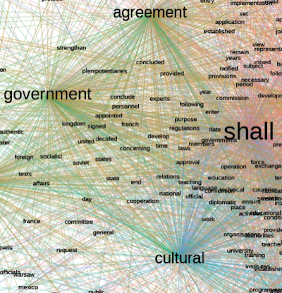The Culture of International Society
Cultural Treaties and the Emergence of a Global Culture Concept, 1919-1972
Details
- Funder: Riksbankens jubileumsfond
This project is closed
Project Description
This project uses cultural treaties – bi-lateral agreements among states that promote and regulate cooperation and exchange in the fields of life we call cultural or intellectual – as a historical source with which to explore the international history of the culture concept in the twentieth century. Specifically, the project investigates the hypothesis that this concept, in contrast to earlier ideas of civilization, played a key role in the consolidation of the post-imperial international order after World War II.
Working in collaboration with Umeå University’s Humlab, the project’s multimethod approach makes use of methods associated with the digital humanities to examine bilateral cultural treaties from 1919, when such agreements came into frequent use, to 1972, by which time such treaties regulated a fully global network of cultural relations. I approach these treaties through two data sets. Basic information, or “metadata” (countries, date, topic, etc.) for cultural treaties is available through the World Treaty Index. We access the content of these agreements through a large sample of treaty texts from countries across the world, which we have assembled and curated. Through purpose-built digital tools, we use various forms of quantitative analysis to analyze, visualize, and explore these datasets. In parallel, the project explores the historical process by which a certain class of treaties came to be classified as “cultural” in the first place.
The central questions that this project explores can be divided into two groups. First, what is the story of the cultural treaty, as a specific tool of international relations, in the twentieth century? What was the historical curve of cultural treaty-making? For example, in which political or ideological constellations do we find (the most) use of cultural treaties? Among which countries, in which historical periods? What networks of relations were thereby created, reinforced, or challenged? Second, what is the “culture” addressed in these treaties? That is, what do the two signatories seem to mean by “culture” in these documents, and what does that tell us about the role that concept played in the international system? How can quantitative work on this dataset advance research questions about the history of concepts?

Co-occurrence network of terms in a sample of cultural treaties, visualization by Fredrik Norén, Humlab, 2019 (detail)
About the Project
Project Duration
2017–2020
